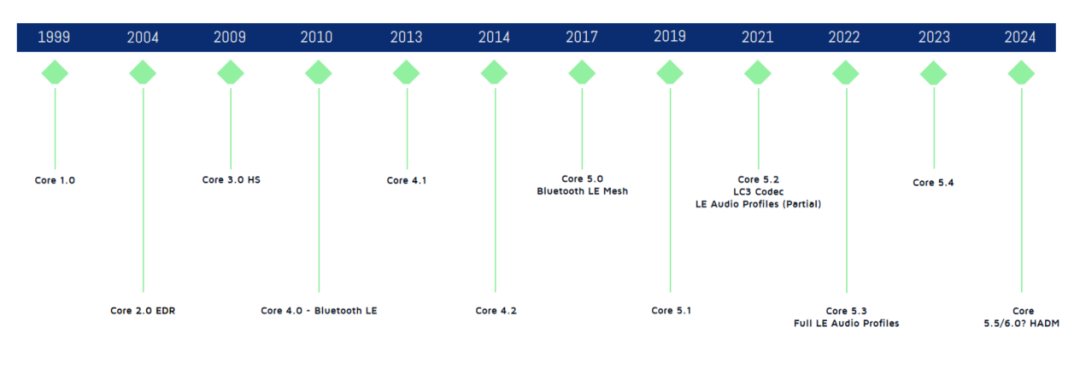Bluetooth is a short-range wireless communication technology based on the 2.4GHz ISM band, characterized by low power consumption, low cost, and convenience. It is widely used in smartphones, computers, wireless remote controls, and other scenarios, making it one of the mainstream technologies for wireless communication. Since the release of the first Bluetooth version by the Bluetooth Special Interest Group (SIG) in 1999, Bluetooth technology has evolved over more than 20 years. From Bluetooth 1.0 to Bluetooth 5.4, each version has iterated with different features. Versions 1.0 to 3.0 are mainly related to classic Bluetooth, while this article focuses on the iterative features of low energy Bluetooth (Bluetooth 4.0 and later).
-
The Bluetooth Special Interest Group (SIG) was established in 1998 and is a non-profit organization that promotes Bluetooth technology, with over 36,000 members worldwide.
-
The Bluetooth SIG mainly focuses on the following activities:
– Creating Bluetooth specifications
– Driving Bluetooth interoperability through certification programs
– Increasing Bluetooth awareness
-
The development history of Bluetooth standards

1
Main Features of Bluetooth 4.0
Bluetooth 4.0 is the first version to introduce the LE standard, with the main advantage being low power consumption. It defines a point-to-point connection micro-network structure, where the Peripheral establishes a data connection through Advertising with the Central, and both Advertising and Peripheral Connection can enter a low power sleep state outside of data transfer tasks; the Central establishes a data connection through Scan with the Peripheral, and both Scan and Central Connection can also enter a low power sleep state outside of data transfer tasks.
It includes basic functions to achieve point-to-point connections.
-
Increased LE PHY
-
Increased LE Link Layer
-
Added LE test mode
-
ATT/GATT
-
AES encryption and Security Manager (SM)
-
Enhancements to L2CAP, GAP, and HCI for LE
2
Main Features Evolution of Bluetooth 4.1
Bluetooth 4.1 features minor changes, mainly to support the coexistence of BR/EDR and BLE, while the underlying link can support different roles and introduce LE Privacy features, allowing Bluetooth addresses to be hidden, thus protecting user privacy from device tracking.
01
LE dual mode topology and
Dual mode Addressing
Compared to the previous version, the topology structure has been expanded to allow dual-mode BR/EDR and BLE, enabling multiple different roles to exist simultaneously at the link layer.
02
LE L2CAP connection oriented channel
Provides more efficient data transmission between two Bluetooth low energy devices, allowing multiple logical channels to exist simultaneously.
03
Low duty cycle directed adv
Direct broadcast increases low duty cycle mode, allowing for longer connection durations and lower instantaneous broadcast power consumption.
04
LE Privacy1.1
Defines basic concepts of Privacy to achieve address privacy protection for devices.
05
LE Ping
Devices can periodically check whether the peer device is online and whether the encrypted data sequence number is correct through Ping Command.
3
Main Features Evolution of Bluetooth 4.2
Bluetooth 4.2’s main changes include an increase in single PDU data transmission length, improving data transfer rates, enhancing user experience during data interactions. Additionally, LE secure connection increases privacy protection, making it impossible for peripheral devices or sniffers to decrypt data once LE secure connection is enabled.
01
LE Data Packet Length Extension
Allows the maximum data length of PDU to be 257 bytes, while the previous version’s maximum data length was 33 bytes, which can enhance link data throughput.
02
LE Secure Connection
Uses ECDH for key exchange and LTK generation, providing a higher level of protection against eavesdropping and MITM attacks.
03
Link layer Privacy
The RPA resolution function has been moved from the host side to the link layer, allowing for quicker identification of the peer device and enhancing operational flexibility.
04
Link layer extended scanner filter
policies
Scan whitelist filtering introduces a special mechanism.
4
Main Features Evolution of Bluetooth 5.0
Bluetooth 5.0 has significant changes, supporting 2M PHY, with a transmission rate twice that of previous versions, allowing users to experience noticeable speed improvements. Additionally, the introduction of Long Range enables greater transmission distances, while LE Advertising Extensions significantly expand the range of broadcasting, with major improvements in channels, PHY, data length, and broadcasting functionality.
01
Increased 2Mbps LE PHY
2M PHY is an optional supported PHY with a rate of 2Mbps, doubling the data bandwidth of 1M PHY.
02
Increased LE Long range, S2 (500kbps),
S8 (125Kbps)
Allows for greater transmission distances.
03
Increased High duty cycle non-connectable
ADV
The minimum broadcast interval has been reduced from 100ms to 20ms, allowing the peer device to scan faster.
04
LE ADV Extensions
-
Extend ADV uses 40 channels instead of the previous 3 channels
-
Allows larger ADV PDU (31bytes -> 254bytes)
-
Introduced periodic broadcasting
-
Allows multiple broadcast sets to exist simultaneously (up to 16)
05
LE Channel Selection Algorithm #2
The hopping algorithm has only 12 different hopping sequences, while the new hopping algorithm 2 is more random.
06
Higher output power
The maximum transmission power has increased from 10mW in versions 4.0/4.1/4.2 to 100mW.
5
Main Features Evolution of Bluetooth 5.1
Bluetooth 5.1 mainly introduces direction finding capabilities, providing technical support for indoor positioning services.
01
Angle of Arrival (AoA) and
Angle of Departure (AoD)
New AoA/AOD technology is introduced to determine device direction, providing location services functionality.
02
Advertising Channel Index
Allows broadcast events to increment in any order across the three primary channels, while previous versions only allowed sequential increments on the three primary channels.
03
GATT Caching
Whenever a client device connects, it performs a “service discovery” to see the functions supported by the server device, which consumes time and power. With the introduction of GATT Caching in Bluetooth 5.1, the client can skip the service discovery process without any changes on the server side, meaning faster connection speeds and lower power consumption.
04
Periodic Advertising Sync Transfer
Introduces the ability to transfer synchronized information of periodic broadcasts scanned to another device via ACL connection.
6
Main Features Evolution of Bluetooth 5.2
Bluetooth 5.2 shows more significant changes compared to other versions, mainly extending audio applications. It allows time-sensitive data to be transmitted to one or more devices for time-synchronized processing, with primary application scenarios including private audio sharing, public audio broadcasting, and assisting hearing aids.
01
LE Isochronous Channel
Defines a time-dependent data transmission channel and transmission strategy for low-latency audio data transmission, introducing connection channels (CIS) and unconnected channels (BIS).
02
LE Power Control
Allows peer devices to request modifications to the transmission power of the peer device based on received signal strength and their own sensitivity, aiming to save power.
03
Enhanced Attribute Protocol (EATT)
EATT allows for parallel data transmission without interference, reducing blocking when multiple applications use low energy Bluetooth devices, thus lowering end-to-end latency and providing a better user experience.
7
Main Features Evolution of Bluetooth 5.3
Bluetooth 5.3’s main changes focus on reducing power consumption, minimizing device latency, improving anti-interference capabilities, and enhancing security performance.
01
AdvDataInfo in Periodic ADV
In the periodic broadcast field, the advDataInfo field has been added, allowing identification of whether the current data has been received before. If it is duplicate data, it can be discarded to save data processing time.
02
LE Enhanced Connection Update
Enables rapid and effective switching from a lower bandwidth to a higher bandwidth to handle bursts of large data transmission, and can quickly reduce current bandwidth after large data exchanges to save energy.
03
LE Channel Classification
New peripherals can send suggested channel requests to the central based on their own packet reception quality and surrounding channel interference information, allowing the central to make appropriate decisions to obtain the best channel and avoid heavily interfered channels. In previous versions, peripheral devices could not send channel information to central devices.
04
Host to controller encryption
key control enhancements
Increases encryption key length through negotiation and specifies a minimum key length to enhance link security.
8
Main Features Evolution of Bluetooth 5.4
Bluetooth 5.4 shows fewer changes, mainly introducing periodic advertising response (PAwR) features, providing a standard protocol framework for the rapidly growing electronic shelf label (ESL) market, further expanding the application scope of Bluetooth.
01
Advertising Coding Selection
When sending extended broadcasts, the Host can specify which codec encoding method to use on LE PHY.
02
Encrypted Advertising Data
Allows ADV data to be encrypted using pre-shared session keys to prevent device tracking based on ADV data. When combined with private addresses, it can prevent eavesdropping and attacks, achieving better privacy protection.
03
LE GATT Security Levels
Characteristics
Introduces Security Level Characteristics (SLC), allowing clients to determine GATT server security conditions. These conditions must be met to grant the peer device access to all GATT functions.
04
Periodic Advertising with Response
Previous versions of periodic broadcasting only allowed unidirectional communication from the broadcaster to the observer, while PAwR enables bidirectional interactive connectionless communication, allowing a single access point to communicate bidirectionally with thousands of terminal nodes.
9
Potential Major Feature Evolution of Bluetooth 5.4+ (Prediction)
01
High Accuracy Distance Measurement,
AKA, Channel Sounding
Mainly used for distance positioning scenarios.
Bluetooth versions are backward compatible, and higher versions have more powerful features. The iteration of Bluetooth versions is rapid, covering more application areas. Telink has been deeply involved in the low energy Bluetooth market for over a decade, keeping up with the latest technology trends and timely launching a series of competitive chips and application solutions to facilitate customers in developing competitive products. Currently, Telink’s mass-produced chips and upcoming mass-produced chips support the following Bluetooth version features:
-
TLSR8208: 1Mbps, 2Mbps
-
TLSR825x: Added S2, S8 modes, EXT ADV, CSA #2, Mesh Support
-
TLSR827x: Added AoA/AoD
-
TLSR921x: Added CIS, BIS, IAL, PCL, PAST, Subrate, PAwR, etc.
-
TLSR922x: Added Channel Sounding
Both TLSR921x and 922x can support features like PAwR in 5.4 through software upgrades.

About Telink
Telink Microelectronics is dedicated to providing customers with one-stop low power, high-performance wireless connectivity SoC chip solutions, including classic Bluetooth, low energy Bluetooth, Bluetooth Mesh, Zigbee, Thread, Matter, Apple HomeKit, Apple “Find My,” and private protocols, as well as a rich firmware protocol stack for low power 2.4GHz multi-protocol wireless connectivity system-level chips. The company’s products are widely used in smart lighting, smart home/building, smart remote controls, wireless peripherals, smart retail, wearable devices, wireless audio, smart toys, logistics tracking, smart cities, and various consumer and commercial application scenarios.
Official Website: www.telink-semi.com
WeChat Official Account: telink-semi
Telink Developer Forum:
https://developers.telink-semi.cn/
Sales Contact:
China Mainland (East China, North China):
+86-21-20281118-8213
China Mainland (South China, Hong Kong, Audio):
+86-0755-26614003
